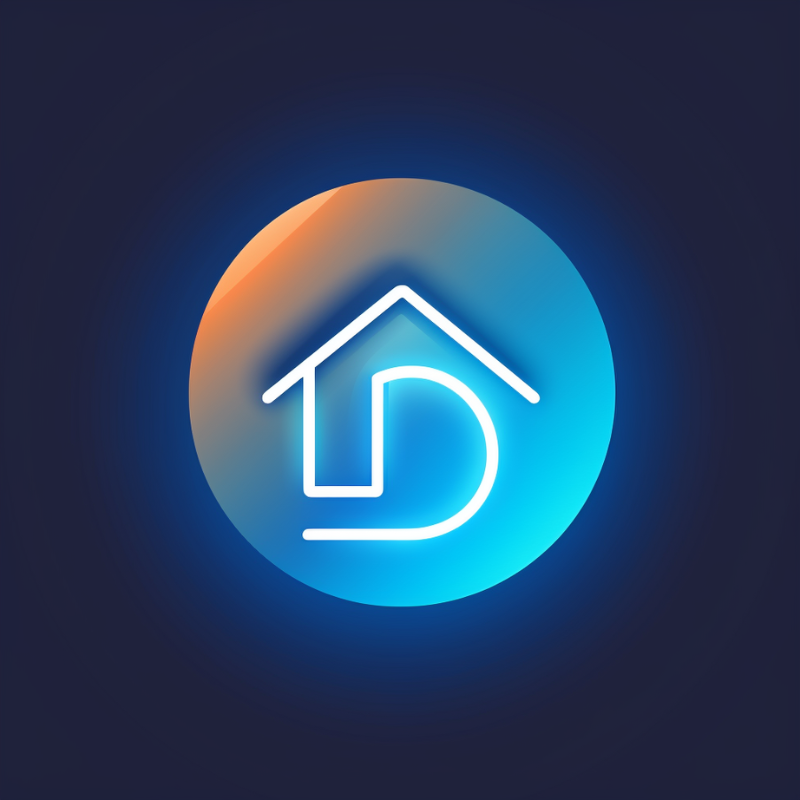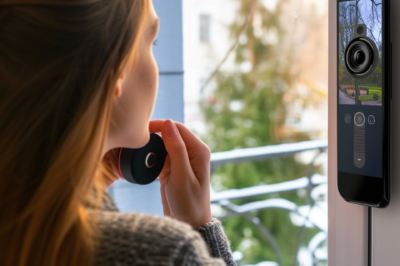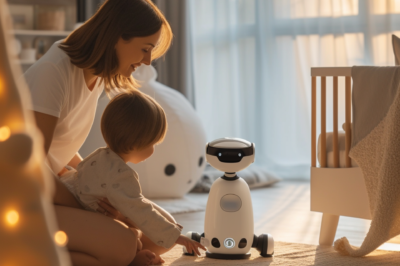
How Smart Homes Can Assist
- Understanding Smart home automation can significantly improve the daily lives of the disabled and elderly.
- Identifying the best smart devices to enhance accessibility, safety, and comfort in the home.
- Getting setting up for a secure and reliable smart home network.
- Explore smart solutions like climate control, voice-activated systems, and smart lighting for increased comfort.
- Implement safety measures through smart locks, cameras, and emergency response systems for peace of mind.
What Smart Home Automation Means for Daily Living
Imagine being able to control your home environment with just your voice or a simple tap on a screen. For individuals with disabilities or the elderly, smart home automation allows them to do just that. It means lights that turn on as soon as you enter a room, thermostats that adjust to your perfect temperature, and doors that lock themselves at night. It’s about making your home work for your convenience and safety.
How Do Smart Home Solutions Promote Independence?
Smart home solutions allow individuals to control their environment, manage daily tasks, and receive assistance without relying on others. They provide the freedom to live life on one’s own terms, despite any physical limitations.
Is Voice Control Accessible for Non-Tech-Savvy Users?
Yes, voice control is designed to be intuitive. With simple commands, users can control devices without needing to navigate complex menus or settings. It’s as easy as speaking to a friend.
The Impact of Smart Devices for Assisted Living
Smart devices aren’t just flash in the pan gadgets; they’re tools that can provide increased independence and security. For someone with limited mobility, a smart doorbell that shows who’s at the door and allows them to unlock remotely on a smartphone can eliminate the need to move quickly. For those with visual impairments, voice-activated devices can read out the news, answer calls, or send emergency alerts without the need to locate and press small buttons.
The Foundation of Home Automation
Before looking into the world of smart home technology, it’s essential to understand the basics. A smart home for the disabled and elderly is designed to simplify tasks, enhance safety, and increase comfort. The foundation lies in choosing devices that are compatible, easy to use, and serve a specific need.
- Start with a central hub: a device that connects and controls all other smart devices.
- Ensure compatibility: all devices should communicate seamlessly with the hub and each other.
- Prioritize usability: opt for devices with straightforward interfaces and clear instructions.
Once the foundation is set, the next step is tailoring the smart home to your unique requirements.
Choosing the Right Devices for Your Needs
Every individual’s needs are different, and so should be their smart home setup. When selecting devices, consider factors like ease of use, the level of assistance required, and the specific challenges faced. Here are some smart device categories to explore:
- Smart speakers for voice control and virtual assistance
- Automated lighting systems for better visibility and energy efficiency
- Smart thermostats for maintaining a comfortable environment
- Wearable health monitors for tracking vitals and detecting falls
These devices not only provide convenience but also offer an extra layer of safety and independence.
Establishing a Robust and Secure Network
A reliable network is the backbone of any smart home. It’s what keeps your devices connected and functioning properly. Most importantly, a secure network protects against unauthorized access, ensuring your personal information stays private. Here’s how to set up a robust network:
- Choose a quality router with strong encryption (like WPA3).
- Regularly update all devices and the router firmware to patch any security vulnerabilities.
- Use strong, unique passwords for your Wi-Fi network and all connected devices.
With these measures in place, you can rest assured that your smart home is not only smart but also secure.
Monitoring Entry Points with Smart Locks and Cameras
Security is paramount, especially for the disabled and elderly who may be more vulnerable to intruders. Smart locks and cameras provide a sense of security by allowing you to monitor and control who enters your home. You can lock and unlock doors remotely, see live video feeds, and even receive alerts when someone approaches your door. This means you can stay safe without having to physically check each entry point, which can be a relief for those with mobility challenges.
Emergency Response Systems: Instant Assistance When Needed
Accidents or medical emergencies can happen at any time, and immediate assistance is crucial. An emergency response system is like having a 24/7 lifeline. With the press of a button or a voice command, help can be summoned without delay. These systems often come with wearable devices, making them accessible from anywhere in the home.
But, how do you choose the right system? Here are a few things to consider:
- Does the system offer two-way communication with emergency operators?
- Can it detect falls automatically?
- Is it easy to wear or carry around?
Most importantly, make sure the system you choose is reliable and has a good track record of quick responses.
Safeguarding Health with Advanced Alert Capabilities
Smart home technology has many health benefits. Advanced alert systems can monitor for signs of distress or unusual activity and notify caregivers or emergency services. This can include alerts for missed medications, sudden changes in vital signs, or lack of movement for an extended period. These systems provide a protective layer, ensuring that in case of any health concerns, there’s always a backup plan.
Maintaining Connections: Communication and Assistance
In a world where staying connected is more important than ever, smart home devices ensure that the disabled and elderly are never out of reach. These devices can facilitate easy communication with loved ones and caregivers, providing both social engagement and assistance when needed.
Digital Companionship Through Smart Speakers and Displays
Smart speakers and displays act as digital companions, offering company, entertainment, and a way to stay in touch with family and friends. They can read audiobooks, play music, make video calls, and even help with grocery shopping by creating lists or placing orders online.
Remote Support and Check-Ins with Connected Devices
With smart home devices, caregivers can check in on loved ones remotely, ensuring their well-being without being intrusive. Devices can be set up to send notifications for routine activities or any deviations from the norm. This not only provides reassurance for caregivers but also empowers those living alone with the knowledge that someone is always looking out for them.
Smart Management: Health and Medication at Your Fingertips
Managing health and medication schedules can be a complex task, but smart home technology simplifies it. With the right setup, reminders can be programmed for medication times, doctor appointments, and exercise routines. This helps maintain a structured daily plan, which is essential for both health management and establishing a sense of normalcy.
Medication Reminders and Dispensers
Forgetfulness can be a real issue, particularly with medication. Smart dispensers issue reminders and release the correct dosage of medication at preset times. This not only ensures that medication is taken properly but also alleviates the stress of managing multiple medications. Such devices are often simple to set up and can be monitored by caregivers remotely.
Fitness and Health Trackers for Daily Wellness
Staying active and monitoring health is easier with fitness and health trackers. These devices can track steps, monitor heart rate, and even analyze sleep patterns. Some can be synced with other smart home devices to provide a comprehensive overview of daily wellness, encouraging a healthier lifestyle with tangible goals.
When choosing a tracker, consider:
- The type of data it collects and how it’s presented.
- The ease of wearing the device throughout the day.
- How it integrates with other health management tools you may use.
It’s about finding the right balance between functionality and comfort.
Customizing Your Smart Home Experience
Your smart home should be tailored to your lifestyle and needs. Customization is key, and it’s easier than you might think. By setting up routines and commands that fit your daily schedule, you can automate tasks and control devices exactly how you want them.
Establishing Routines and Custom Commands
Smart devices can be programmed to perform a sequence of actions based on triggers like the time of day, your location, or a specific command. For example, a “good morning” routine could open the curtains , turn on the lights, and the heating or cooling — all with a single voice command. Setting up these routines not only adds convenience but also ensures consistency, which can be particularly comforting for those with memory issues.
Remember, the goal of home automation is to make life easier and safer for the disabled and elderly. By carefully selecting devices that suit individual needs, setting up a secure network, and customizing the smart home experience, we can create a living space that not only accommodates but also empowers. Whether it’s through enhanced comfort, improved safety, or maintaining vital connections, smart home solutions offer a world of possibilities to live independently and with dignity.
Adapting Technology to Changing Needs
As we age or as our abilities change, our needs at home evolve. The beauty of smart home technology is its adaptability. Devices that were once helpful can be updated or replaced to better serve new requirements. For instance, if mobility becomes more limited, motion sensors can be added to automate lighting, preventing the need to reach for switches. It’s important to regularly assess and adjust your smart home setup to ensure it continues to serve you best.
Getting Started: Steps to a Smarter Home
Embarking on the journey to a smarter homedoesn’t have to be ovrewhelming. Breaking it down into steps makes it manageable. Start by identifying the areas of your life where you need the most assistance or where safety could be improved. Then, research and select devices that meet these needs and are within your budget. Finally, set up your devices and customize them to fit your daily routines.
Assessing Home Automation Needs and Goals
Begin by considering the following questions:
- What tasks do you find challenging or tiresome?
- Are there any aspects of your home that feel unsafe?
- What routines would you like to simplify?
Answers to these questions will guide you in choosing the right smart home solutions.
Practical Steps to Implementing Your Smart Home Solutions
Once you’ve chosen your devices, follow these steps:
- Install one device at a time to avoid feeling overwhelmed.
- Test each device to ensure it works as expected and meets your needs.
- Gradually build up your system, adding devices as you become comfortable with the technology.
Patience is key—take your time to familiarize yourself with each new addition.
Frequently Asked Questions (FAQ)
What Are the Best Starter Smart Devices for a Beginner?
For those new to smart home technology, consider starting with:
- Smart speakers for voice control and daily assistance
- Smart plugs to remotely control lamps and small appliances
- Smart light bulbs for easy brightness and color adjustments
These devices are user-friendly and offer immediate benefits.
Can Home Automation Be Budget-Friendly?
Absolutely. You don’t need to buy everything at once or choose the most expensive options. Start small with essential devices and expand your system as your budget allows.
Are There Any Privacy Concerns with Smart Home Devices?
While smart devices are convenient, they do raise privacy concerns. It’s crucial to use devices from reputable brands, keep software up to date, and use strong, unique passwords to mitigate these risks.



